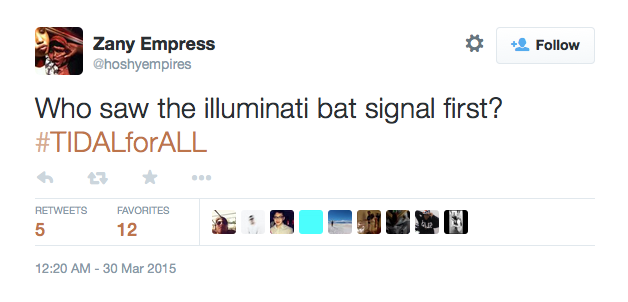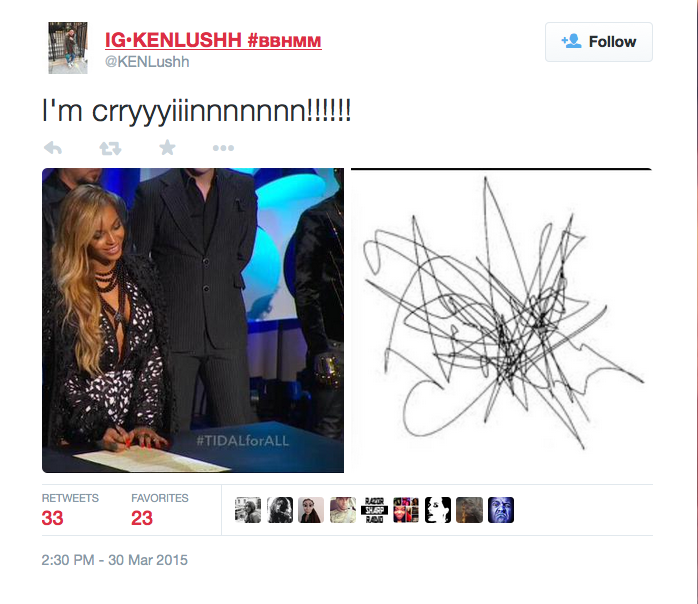3 Lessons We Learned From Tidal’s Splash Back Into The Industry
The Internet is still ablaze with news of Tidal, the Jay Z-owned streaming service you can pay $20 a month for… if you’re into that sort of thing. Tidal will apparently “change the game” and is backed by a smorgasbord of famous musicians, but the internet thinks differently.
Guest Post by DONNÉ TORR on Hootsuite Blog
While the addition of a new supposedly superior music streaming service is big news, what we find more interesting is the Internet’s reaction to Tidal. People are enraged. From headlines like The World’s Most Famous Musicians Just Hosted a Bonkers Press Conference, and Jay Z’s 99 Problems: Music Stars Aren’t Very Good at Launching Startups, to This Bizarre Advert for Tidal Is Like a Softcore American Psycho, either Tidal’s marketing team lives by the mantra “any press is good press” or they missed the mark with their PR campaign. As a result, we have compiled 3 lessons we can all take from Tidal’s launch.
3 Lessons For Marketers From TIDAL’s Splash
1. Know your audience
If you think you know and understand your audience, double check until there is no room for failure. Hey, maybe even put yourselves in their shoes for a moment. The audience this product targeted (i.e. pretty much the entire whole world) did not eat it up. Rather, there was a swift and harsh backlash. From #antitidal campaigns, and comparing them to the Illuminati, there is no shortage of stabs at Tidal. Why? The service is more expensive than many of its alternatives, and the superior sound quality it claims—which it’s charging extra for—has been called into question. It turns out people don’t feel bad for a crew of ‘struggling artists’ who are actually multi-bazillionaires.
2. Social media won’t forgive your mixed messages
If you run a men’s clothing line, then target your branding towards men. If you are trying to sell ankle weights to ladies who prancersize, then adjust your marketing towards that demographic. If you are trying to market a music streaming service to everyone that listens to music, don’t create a video that makes it clear you seem to think only men listen to music or appreciate good sound.
As our friends at Noisey put it, this video makes it clear that Tidal was meant for men “because men have larger, more biologically developed ears—like massive sagging, fleshy satellite dishes hanging from the sides of our large übermensch, world-dominating skulls—and therefore we require the highest forms of lossless audio.” They even set up a test to see if you’re “ready for their product.” Way to turn the rest of us ‘common folk’ away.
3. A social media movement is only as powerful as the audience that can participate
Along with the #antitidal movement, there are those that question the motives of this music revolution. Regardless of the fact that most of the artists that support Tidal get equity in the actual company, the hashtag #TIDALforALL ended up working against itself when the new hashtag @TIDALforNOONE started trending. It’s hard to get the masses participating in a movement that they essentially are excluded out of.



While there is a backlash against Tidal and they certainly did not have a well thought out campaign, the media(including Hypebot) did nothing to help Tidal. One could even surmise they went out of their way not to help.
1. Almost every media story(including the one above) made a big deal out of the $19.99 monthly fee. However as you well know(but fail to report) Tidal has a $9.99 subscription fee. You could of just as easily reported the story as such: “Tidal’s monthly fee is the industry standard $9.99. However, for people who would like better quality audio, there is a $19.99 package.
2. While the average person would might not know the difference between hi fi and medium fi, there absolutely is a huge difference between 96 kbps and lossless. It should be the industry that dictates the standard not the consumer. The music business never asked what the fan thought about vinyl albums, they simply sold them.
3. The biggest misconception about Tidal is one the media did nothing to dispel. Tidal isn’t just trying to get more money for their billionaire owners, they are trying to get more money for all artists. That’s a great thing.
For Hypebot not to understand, clarify and champion these issues because of a perception they would be fighting for the rich music class is shameful.
Ian, I am not sure if you are working for Tidal but all of your points are pointless, because Tidal did not ask for media support. They actually think they don’t need media/press anymore, they can just let their owners post some rubbish on Twitter and that’s it.
It’s just another sign they completely lost contact with their audience and peer groups. It is not the task of media to support Tidal, it is the task of Tidal to come up with a clever concept if they start a buzz like that.